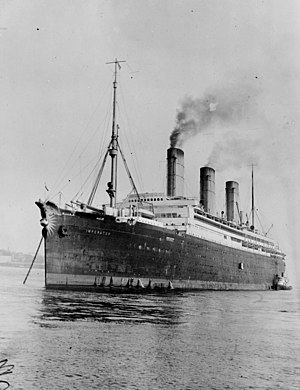SS Imperator

German liner Imperator at anchor, c. 1913, with the grandiose bow eagle of the Hapag company still in place.
|
|
| History | |
|---|---|
|
|
|
| Name: | SS Imperator |
| Owner: | Hamburg America Line |
| Port of registry: | Hamburg |
| Builder: | |
| Launched: | 23 May 1912 |
| Christened: | 24 May 1913 |
| Completed: | June 1913 at Hamburg, Germany |
| Maiden voyage: | 11 June 1913, Cuxhaven to New York |
|
|
|
| Name: | USS Imperator |
| Acquired: | by the Navy 5 May 1919 at Brest, France |
| Commissioned: | 5 May 1919 USS Imperator at Brest, France |
| Decommissioned: | 24 November 1919 at New York City |
| Identification: | ID-4080 |
| Fate: | Sold to the Cunard Line and renamed Berengaria |
|
|
|
| Name: | RMS Berengaria |
| Owner: |
|
| Acquired: | 1919 |
| Homeport: | Liverpool, UK |
| Fate: | Scrapped between 1939–1946 |
| General characteristics | |
| Class and type: | Imperator-class ocean liner |
| Tonnage: | 52,117 GT |
| Length: | 906 ft (276 m) |
| Beam: | 98 ft 3 in (29.95 m) |
| Draught: | 35 ft 2 in (10.72 m) |
| Decks: | 11 |
| Installed power: | Steam generated at 265 psi by 46 watertube boilers of Vulcan Yarrow design, originally coal burning, later converted to oil fired in 1921. |
| Propulsion: | 4 steam turbines AEG-Vulcan / Parsons direct drive on four shafts, total of 60,000 shp (45,000 kW) |
| Speed: | 24 kn (44 km/h; 28 mph) max |
| Capacity: |
|
| Crew: | 1,180 |
SS Imperator was an ocean liner built for the Hamburg America Line (Hamburg Amerikanische Paketfahrt Aktien Gesellschaft, or HAPAG), launched in 1912. Upon launch, she surpassed the just completed RMS Titanic by 24 ft (7.3 m), and she herself was surpassed the same year by SS Vaterland by 44 ft (13 m). She was the first of a trio of successively larger Hamburg America ships that included SS Vaterland and SS Bismarck built by the line for transatlantic passenger service. At the time of her completion in June 1913, she was the largest passenger ship in the world, surpassing Titanic's sister ship, RMS Olympic.
During World War I, the ship remained in port in Hamburg. After the war, she was briefly commissioned into the United States Navy as USS Imperator (ID-4080) and employed as a transport, returning American troops from Europe. Following her U.S. Navy service, Imperator was handed over to Britain's Cunard Line as part of war reparations, and she sailed as the flagship RMS Berengaria for the final decade of her career.
The first plates of her keel were laid in 1910 at the Vulcan Shipyards in Hamburg, Germany, and made her maiden voyage in 1913. At 51,680 gross tons, Imperator was the largest ship in the world until Vaterland sailed in May 1914.
Before her launch on 23 May 1912, Cunard announced that their new ship, RMS Aquitania, which was under construction at the time at the John Brown shipyards in Glasgow, would be longer by one foot. There was chagrin in Hamburg. Several weeks later, she was fitted with an imposing bronze eagle figurehead, created by Professor Bruno Kruse of Berlin, which adorned her forepeak with a banner emblazoned with HAPAG's motto Mein Feld ist die Welt (My field is the world); this extension increased Imperator' length sufficiently to (easily) surpass Aquitania. The eagle's wings were later torn off in an Atlantic storm during the 1914 season, after which it was removed and replaced with gold scroll-work which was similar to what was on her stern.
...
Wikipedia
